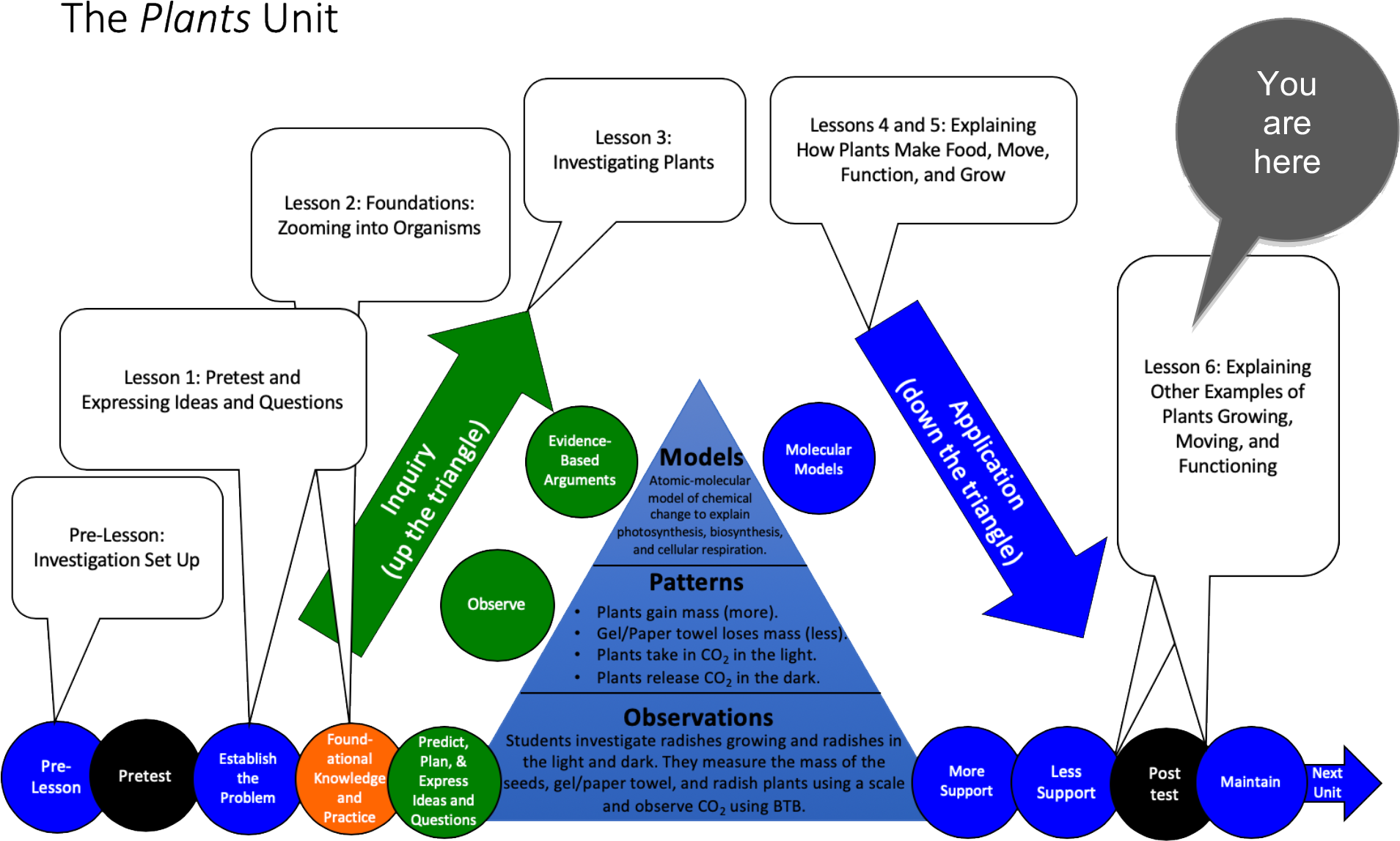Transformations in Matter and Energy Carbon TIME is an NSF-funded partnership led by Michigan State University
Lesson 6: Explaining Other Examples of Plants Growing, Moving, and Functioning
Students practice explaining photosynthesis, biosynthesis, and cellular respiration in other plants and then take the unit posttest.
Guiding Question
How do other plants grow, move, and function?
Activities in this Lesson
- Activity 6.1: Explaining Other Examples of Plants Growing, Moving, and Functioning (50 min)
- Activity 6.2: Functions of All Plants (50 min)
- Activity 6.3: Comparing Plants and Animals (50 min)
- Activity 6.4: Plants Unit Posttest (20 min)
Unit Map

Target Performances
|
Activity |
Target Performance |
|
Lesson 6 – Explaining Other Examples of Animals Growing, Moving, and Functioning (students as explainers) |
|
|---|---|
|
Activity 6.1: Explaining Other Examples of Plants Growing, Moving, and Functioning |
Students develop integrated accounts of how other plants (Lodgepole pine, Spartina marsh grass, prickly pear cactus) grow, move and function through the processes of photosynthesis, cellular respiration, and biosynthesis. |
|
Activity 6.2: Functions of All Plants |
Students develop integrated accounts of how all plants grow, move and function through the processes of photosynthesis, cellular respiration, and biosynthesis. |
|
Activity 6.3: Comparing Plants and Animals |
Students compare how matter moves and changes and how energy changes in a growing tree vs. a growing child, connecting macroscopic observations with atomic-molecular models and using the principles of conservation of matter and energy. |
|
Activity 6.4: Plants Unit Posttest |
Students show their end-of unit proficiencies for the overall unit goal: Questioning, investigating, and explaining how plants move and change matter and energy as they live, move, and grow. |
NGSS Performance Expectations
Middle School
- MS. Structure, Function, and Information Processing. MS-LS1-3. Use argument supported by evidence for how the body is a system of interacting subsystems composed of groups of cells.
- MS. Matter and Energy in Organisms and Ecosystems. MS-LS1-6. Construct a scientific explanation based on evidence for the role of photosynthesis in the cycling of matter and flow of energy into and out of organisms.
- MS. Matter and Energy in Organism and Ecosystems. MS-LS1-7. Develop a model to describe how food is rearranged through chemical reactions forming new molecules that support growth and/or release energy as this matter moves through an organism.
High School
- HS. Matter and Energy in Organisms and Ecosystems. HS-LS1-5. Use a model to illustrate how photosynthesis transforms light energy into stored chemical energy.
- HS. Matter and Energy in Organisms and Ecosystems. HS-LS1-6. Construct and revise an explanation based on evidence for how carbon, hydrogen, and oxygen from sugar molecules may combine with other elements to form amino acids and/or other large carbon-based molecules.
- HS. Matter and Energy in Organisms and Ecosystems. HS-LS1-7. Use a model to illustrate that cellular respiration is a chemical process whereby the bonds of food molecules and oxygen molecules are broken and the bonds in new compounds are formed resulting in a net transfer of energy.
- HS. Matter and Energy in Organisms and Ecosystems. HS-LS2-5. Develop a model to illustrate the role of photosynthesis and cellular respiration in the cycling of carbon among the biosphere, atmosphere, hydrosphere, and geosphere.
Talk and Writing
This lesson of the unit represents the fading portion of the Explanations Phase. This means that students are expected to develop explanations for carbon-transforming processes they studied in this unit in new and novel contexts. The table below shows specific talk and writing goals for the Explanations phase of the unit.
|
Talk and Writing Goals for the Explanations Phase |
Teacher Talk Strategies That Support This Goal |
Curriculum Components That Support This Goal |
|---|---|---|
|
Examine student ideas and correct them when there are problems. It’s ok to give the answers away during this phase! Help students practice using precise language to describe matter and energy. |
Let’s think about what you just said: air molecules. What are air molecules? Are you talking about matter or energy? Remember: atoms can’t be created. So that matter must have come from somewhere. Where did it come from? Let’s look at the molecule poster again… is carbon an atom or a molecule? |
Molecule Poster Three Questions Poster
|
|
Focus on making sure that explanations include multiple scales. |
The investigation gave us evidence for what was happening to matter and energy at a macroscopic sale. But what is happening at an atomic-molecular scale? What is happening to molecules and atoms? How does energy interact with atoms and molecules during chemical change? Why doesn’t the macroscopic investigation tell us the whole story? Let’s revisit our scale poster… what is happening to matter at the molecular scale? |
Molecular Models Molecular Modeling Worksheets Explanations Tool PPT Animation of chemical change Powers of Ten Poster |
|
Encourage students to recall the investigation. |
When did this chemical change happen during our investigation? How do we know that? What is our evidence? What were the macroscopic indicators that this chemical change took place? |
Evidence-Based Arguments Tool Investigation Video |
|
Elicit a range of student explanations. Press for details. Encourage students to examine, compare, and contrast their explanations with others’. |
Who can add to that explanation? What do you mean by _____? Say more. So I think you said _____. Is that right? Who has a different explanation? How are those explanations similar/different? Who can rephrase ________’s explanation? |
Explanations Tool |

 Download PDF of Lesson 6 Teacher's Guide
Download PDF of Lesson 6 Teacher's Guide